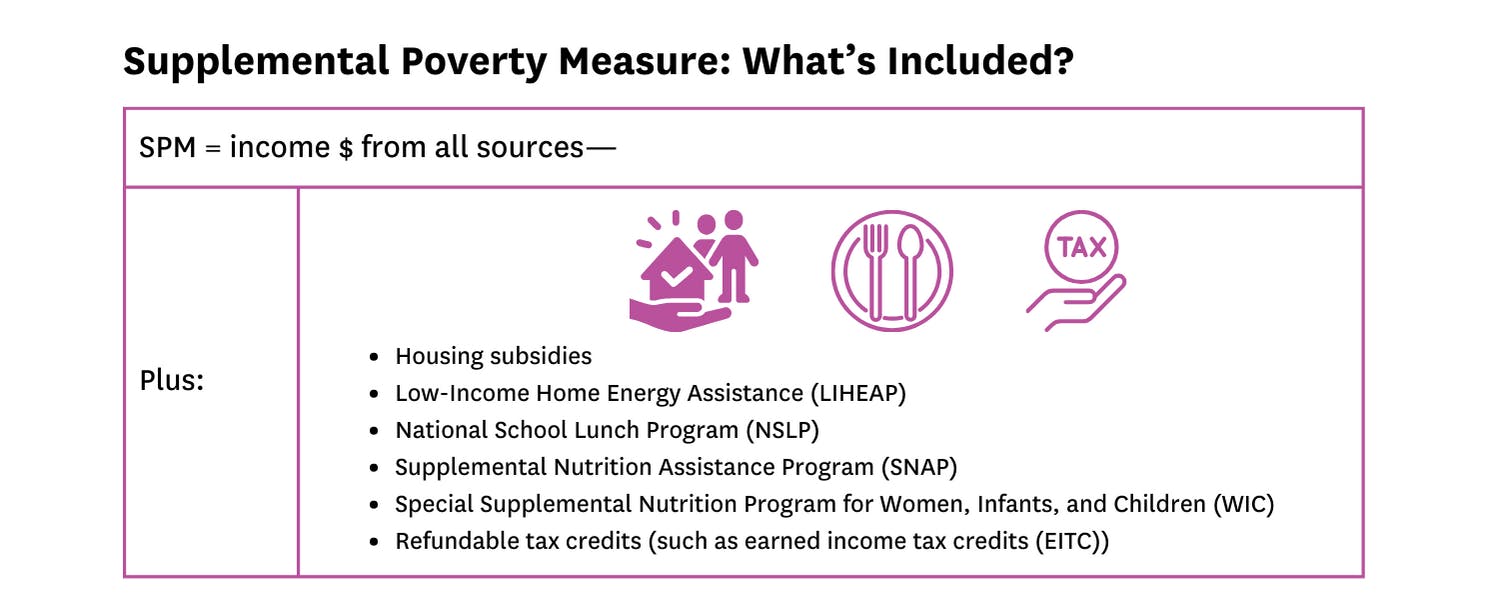

Poverty Will Always Lose the Fight Against Income Support: We Can Prove it, Too!
Insights
January 23, 2024
By: Julie Kronick, Rimsha Khan, & Robert Guttersohn
There is a large body of research that shows that income support reduces child poverty. In honor of National Poverty Awareness Month, let’s dig a bit deeper into some numbers around measures of poverty in New York City and how this can inform real poverty reduction solutions.
Did you know there is a different measure of poverty that factors in some supportive programs? Outside of the Official Poverty Measure (OPM), a now commonly used measure is called the Supplemental Poverty Measure (SPM), which considers a slightly different picture of a family’s financial circumstances. The SPM was established in 2010 to provide a fuller picture of “modern financial life” for families, in two key ways: more current expenses for food, clothing, shelter (OPM’s measure is based on older standards) and the amount of tax credits and noncash benefits that a family receives as part of total income, while select expenses are deducted. While the OPM is useful in understanding an overall national threshold, and is important in navigating disparity, the SPM helps us to explore the impact of supplemental income on child poverty. As advocates for eradicating child poverty, and as an organization working on the advisory council for New York’s commitment to reduce child poverty, we are fiercely supportive of supplemental income programs and there is ample data, within and outside of the SPM, that demonstrably proves these programs are key in reducing child poverty.

Why does measuring SPM matter?
To dive a bit deeper into the data difference, the U.S.’s poverty rate (OPM) tells us what percentage of the population lives below the “poverty line” based solely on income and a federally set threshold. Therefore, the SPM poverty rate for children is typically lower than the official poverty rate because of the non-cash benefits considered additional income. These programs include the Supplemental Nutritional Assistance Program (SNAP), the Special Supplemental Nutrition Program for Women, Infants, and Children (WIC), Housing Voucher Programs, tax credits, etc. In New York City specifically, the most recent data available (2021) shows the child poverty rate at 24% (as shown by CCC’s data on our database) by the OPM’s standards and 15% (as recorded by Columbia’s Center on Poverty and Social Policy and Robin Hood Foundation) by the SPM’s standards.
Supplemental Poverty Measure vs Official Poverty Measure
Supplemental Poverty Measure
0% children in poverty
Official Poverty Measure
0% children in poverty
The difference between 15% and 24% is both large (in the data world) and representative of the number of families that are positively affected by policies that impact economic security. Through this lens we can see the real impact of assistance—and this becomes even more clear when stood up against data that was analyzed during the height of the pandemic through the American Rescue Plan. Both the SPM and the pandemic-era data on child poverty show what we know deeply as child advocates: children are lifted out of poverty by the choices we make in legislative and budget commitments for income assistance.
Well known programs like SNAP and tax credit options have been available in varying capacities to families in the US for years, implemented to offer financial support to working families. Along these lines, policymakers have long understood the role supplementing income for low earners has played in supporting local economies and family stability and reducing child poverty. What’s more, data that came out of policy interventions in 2020 and 2021 to alleviate the impact of the pandemic further illustrate just how much the fight to end child poverty is about policy choices.
Income supports do make a difference, but they also have the potential to make a HUGE difference
 CCC has been vocal about how the temporary expansion of the Child Tax Credit (CTC) included in the American Rescue Plan (ARP) led to a historic reduction in child poverty, lowering child poverty by more than 40%. The ARP increased the amount of the CTC from $2,000 to $3,600 for qualifying children under age 6, and $3,000 for other qualifying children under age 18. Additional data shows that the expanded CTC payments were used by 9 in 10 families on basic needs like food, clothing, rent/mortgage, or utility bills (data from CCC helps illustrate usage). CTC payments from July to December 2021 supported more than 2 million households and 3 million children in New York State (CCC’s Keeping Tack, pg 19). This data demonstrates just how much certain policy changes can improve quality of life for a large number of families and children.
CCC has been vocal about how the temporary expansion of the Child Tax Credit (CTC) included in the American Rescue Plan (ARP) led to a historic reduction in child poverty, lowering child poverty by more than 40%. The ARP increased the amount of the CTC from $2,000 to $3,600 for qualifying children under age 6, and $3,000 for other qualifying children under age 18. Additional data shows that the expanded CTC payments were used by 9 in 10 families on basic needs like food, clothing, rent/mortgage, or utility bills (data from CCC helps illustrate usage). CTC payments from July to December 2021 supported more than 2 million households and 3 million children in New York State (CCC’s Keeping Tack, pg 19). This data demonstrates just how much certain policy changes can improve quality of life for a large number of families and children.
Last Fiscal Year CCC advocated for the Empire State Child Credit to include children under the age of four, expanding the credit to an additional 600,000-900,000 children statewide. This advocacy was successful, but much more is needed to reach families hardest hit by affordability issues that lead to child poverty. In New York State, roughly 1.1 million children are left out of the full credit because their families’ earnings are too low. The impact of tax credits on reducing child poverty is indisputable and we are pushing state leaders to deepen them.
The impact of tax credits on reducing child poverty is indisputable and we are pushing state leaders to deepen them.
Other supplemental supports considered in the SPM, like SNAP and housing vouchers also significantly impact income stability. During the height of the pandemic, SNAP was also expanded for New Yorkers, supporting families through Emergency Allotments (EAs). An Urban Institute study estimated that EAs kept 4.2 million people above the poverty line in the last quarter of 2021, reducing poverty by 10 percent, and child poverty by 14 percent in the US. Last year, the NYC Council passed legislation that would allow families facing eviction to access housing vouchers with the intention of reducing the number of families entering NYC homeless shelters, which greatly improves financial outlooks for families. In fact, several years ago Matthew Desmond (our 2023 Annual Breakfast Celebration Keynote!) and Carl Gershenson published an article in Social Problems, “Housing and Employment Insecurity among the Working Poor,” which detailed that working renters who lose their home, often as a result of eviction, are 11%-22% more likely to lose their job.
What we can do together to make a change
Income supports play a key role in reducing child poverty, so it is important that we protect access to them and also expand eligibility to more households as an antidote to poverty. CCC’s priorities are focused on just that, with commitment to strengthen tax policy to lift incomes and expand access to public benefits in our state and city priorities.
![]() From our most recent priorities:
From our most recent priorities:
- The State child tax credit must reach the poorest New Yorkers, currently excluded from the full credit, and provide an increased credit amount that would have a meaningful impact on a family’s budget;
- The Earned Income Tax Credit (EITC) must reach all working New Yorkers who are eligible, including those filing with an Individual Tax Identification Number (ITIN);
- Increase the value of cash aid and shelter and prioritize facilitated access;
- Establish a Task Force for a state-funded version of SNAP for All, regardless of immigration status and establish a state SNAP minimum benefit program.
Over the summer last year, we also stood with the Family Homelessness Coalition, partner organizations, and the NYC Council to pass legislation expanding the NYC housing voucher program, CityFHEPS, and are continuing to advocate to see the legislation implemented by Mayor Adams.
We will be creating several take action campaigns that target poverty reduction and economic security in various ways centered around the above priorities. Right now, there is a bill (A06214/ S7663) introduced by Assembly Member Jessica González-Rojas and Senator Rachel May that would increase the minimum SNAP benefit to $100, significantly helping families across the state and in NYC. You can take action on this bill now by sending a letter to Governor Hochul through Feeding New York State.
CCC is also part of a coalition of city and state-based organizations working together (several within the Poverty Reduction Advisory Council) called New York Can End Child Poverty. Click here to read facts about child poverty that dive deeper into how child poverty impacts different households.
We know that there are policy choices—choices that have already been made, and then revoked—that have the demonstrated ability to fight and reduce child poverty. Poverty will always lose the fight against income lifting strategies, from benefits and supports to actual income-impacting legislation, and so it is our responsibility to act on this. Stay connected to us and stand with us as we take action in the coming weeks.



